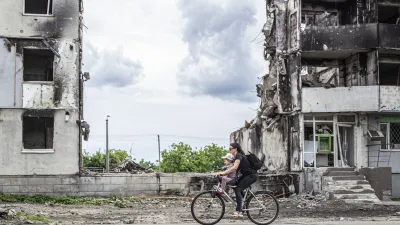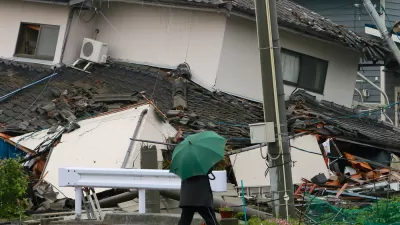Christopher Hawthorne reports from Japan on the many obstacles preventing areas destroyed by the Tōhoku earthquake and tsunami from proceeding with rebuilding, as the recovery effort stalls in the cleanup stage.
Although northeastern Japan has made enormous strides in removing the astonishing amount of debris caused by last year's disaster, Hawthorne outlines the leadership and political roadblocks that have prevented communities from starting in earnest on substantial construction efforts, as some of the largest questions regarding rebuilding go unanswered.
According to Hawthorne, "Prime Minister Yoshihiko Noda, his approval rating in danger of sinking below 30%, has faced wide criticism for failing to articulate a broad vision for rebuilding. The national Reconstruction Agency wasn't officially launched until February, 11 months after the disaster...The most intractable issue is whether the hardest hit fishing villages, already losing population before the disaster, should be rebuilt as they were or consolidated." Larger socio-economic fault lines have also been exposed by the earthquake, and these issues must be discussed as they are likely to guide rebuilding plans.
The lack of progress on rebuilding is not for lack of trying by the country's architects and planners who have worked diligently with local communities to develop plans for reconstruction.
While a larger vision for recovery goes unarticulated, local communities have also struggled to develop consensus on how to rebuild their towns. "Sharp disagreement" amongst local residents and politicians "over reconstruction goals has repeated itself in the smaller towns along the Oshika Peninsula," according to Hawthorne. And "the lack of consensus on basic issues calls into question precisely how" $3.75 billion in rebuilding grants recently approved by the central government will be spent.
FULL STORY: Japan Disaster: A Year Later: Without a blueprint

Planetizen Federal Action Tracker
A weekly monitor of how Trump’s orders and actions are impacting planners and planning in America.

Maui's Vacation Rental Debate Turns Ugly
Verbal attacks, misinformation campaigns and fistfights plague a high-stakes debate to convert thousands of vacation rentals into long-term housing.

San Francisco Suspends Traffic Calming Amidst Record Deaths
Citing “a challenging fiscal landscape,” the city will cease the program on the heels of 42 traffic deaths, including 24 pedestrians.

Defunct Pittsburgh Power Plant to Become Residential Tower
A decommissioned steam heat plant will be redeveloped into almost 100 affordable housing units.

Trump Prompts Restructuring of Transportation Research Board in “Unprecedented Overreach”
The TRB has eliminated more than half of its committees including those focused on climate, equity, and cities.

Amtrak Rolls Out New Orleans to Alabama “Mardi Gras” Train
The new service will operate morning and evening departures between Mobile and New Orleans.
Urban Design for Planners 1: Software Tools
This six-course series explores essential urban design concepts using open source software and equips planners with the tools they need to participate fully in the urban design process.
Planning for Universal Design
Learn the tools for implementing Universal Design in planning regulations.
Heyer Gruel & Associates PA
JM Goldson LLC
Custer County Colorado
City of Camden Redevelopment Agency
City of Astoria
Transportation Research & Education Center (TREC) at Portland State University
Jefferson Parish Government
Camden Redevelopment Agency
City of Claremont




























